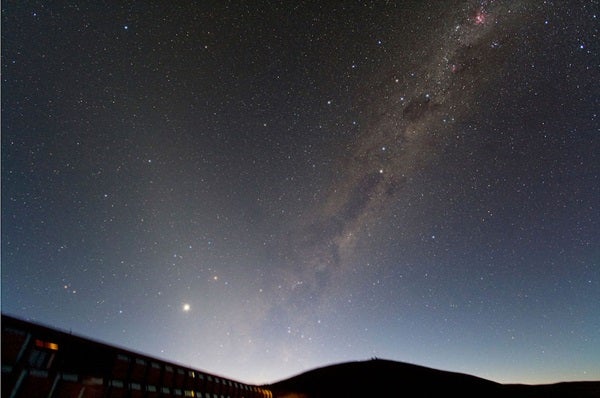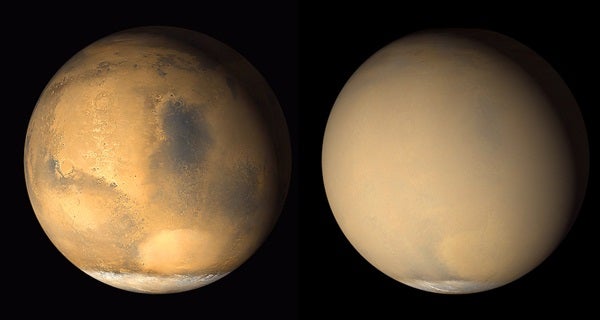At this time of year, there’s a “false dusk” visible after sunset. From a dark location, you can see the cone-shaped glow reaching upward from the western horizon, rising through the constellations Aries and Taurus. In the fall, that same glow is known as a “false dawn,” giving the eastern horizon a similar shimmer just before sunrise.
This phenomenon is known as zodiacal light, and it’s produced by sunlight reflecting off tiny dust grains in the inner solar system. Astronomers have long thought this interplanetary dust is simply debris shed by asteroids and comets over the eons. But a chance find by the Juno spacecraft during its journey from Earth to Jupiter has revealed a new possible source for the dust that causes zodiacal light: Mars.
The find was published March 9 in JGR Planets.
Juno gets dusty
After launching in 2011, Juno took a somewhat circuitous route to Jupiter. It first ventured to the asteroid belt between Mars and Jupiter, then back toward Earth, ultimately using our planet’s gravity to help slingshot itself to its final destination, where it’s been working since 2016.
Along the way, one of Juno’s four star-tracking cameras — which snap photos four times a second — searched for undiscovered asteroids by sending back images whenever unknown objects appeared in successive shots. Few candidates were expected, but thousands of photos poured in.
“The images looked like someone was shaking a dusty tablecloth out their window,” said John Leif Jørgensen of the Technical University of Denmark, who led the Juno’s star-tracking project, in a press release. The camera was seeing tiny pieces of debris — just 0.04 inch (1 millimeter) across or smaller — from Juno’s expansive solar panels, blasted away by interplanetary dust slamming into the array at some 10,000 mph (16,000 km/h).
The hardy panels were strong enough to withstand the bombardment, but it essentially turned Juno’s solar arrays into giant dust detectors, allowing researchers to map how zodiacal dust is scattered throughout the inner solar system.
Although the distribution of this dust has long been inferred by the sunlight we see reflecting off it, precise measurements remain scarce. And those measurements that do exist come from detectors a thousand times smaller than Juno’s three 30-foot-long (9 m) solar panels, offering limited insight.
Mapping interplanetary dust
Juno showed that the zodiacal dust cloud spans from roughly Earth’s orbit to about twice the Earth-Sun distance, reaching just beyond the orbit of Mars. At the cloud’s inner boundary, Earth’s gravity keeps it at bay, while Jupiter’s gravity keeps the dust in check at the cloud’s outer edge. Within those bounds, the majority of the dust has orbital properties that closely resemble those of Mars. And that’s why researchers think the Red Planet itself is the origin of much of the dust.
To explore this strange idea, the team modeled how dust with Mars’ orbital properties would interact with Jupiter’s gravity over time, as well as what sunlight reflecting off this dust would look like. And sure enough, their results closely match the actual appearance of zodiacal light seen from Earth.
“That is, in my view, a confirmation that we know exactly how these particles are orbiting in our solar system and where they originate,” said Jack Connerney, Juno’s deputy principal investigator and lead investigator on the spacecraft’s magnetometer instrument, which relies on the four star-tracking cameras to function.
Zodiacal origin: unknown
Despite Juno’s new find, there’s one lingering yet vital question that remains: How does dust from Mars escape the Red Planet’s gravity and spread out between the planets?
The team notes that the Mars Atmosphere and Volatile EvolutioN (MAVEN) spacecraft orbiting the Red Planet has seen significant amounts of dust around the world. But they can’t know for sure where it came from. Although Mars is famous for its planetwide dust storms, the team says there’s no known physical mechanism for boosting dust from these storms into space.
Alternatively, they suggest, dust generated by micrometeoroid impacts on Mars’ moons Phobos and Deimos could be the source. However, once again, they aren’t sure how this dust would escape the gravity of the Mars system and become interplanetary dust.
Regardless of the origin of zodiacal dust, this new understanding of the cloud’s distribution will help mission planners better safeguard future spacecraft against interplanetary dust collisions, which could severely damage delicate instruments.
And remember, the next time you’re lucky enough to spot the zodiacal light in the sky, you might just be looking at tiny pieces of Mars glimmering in sunlight between the planets.











